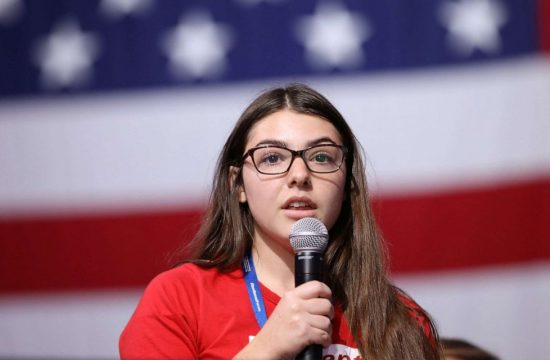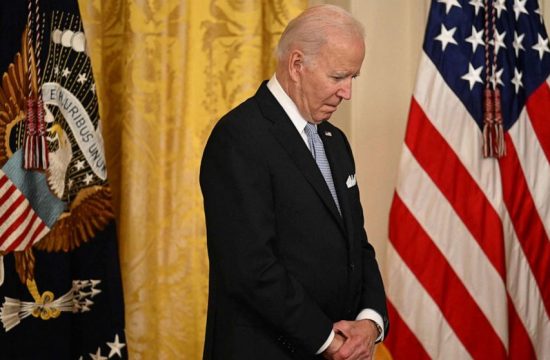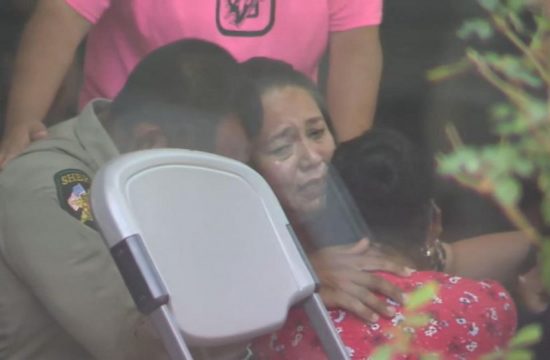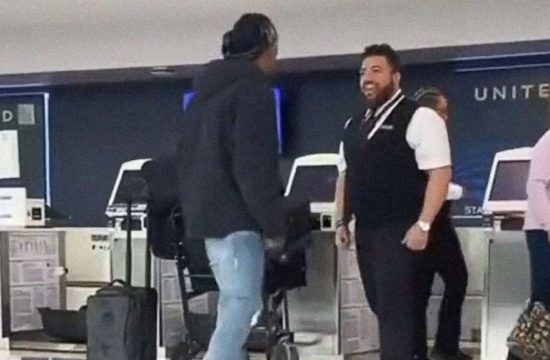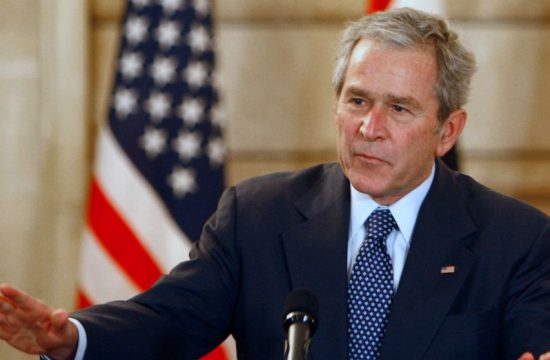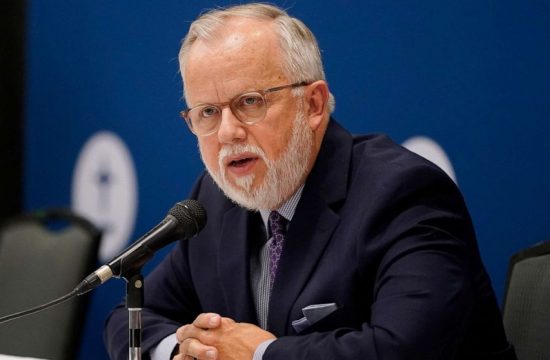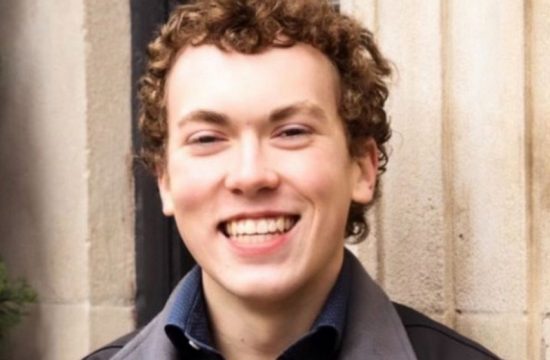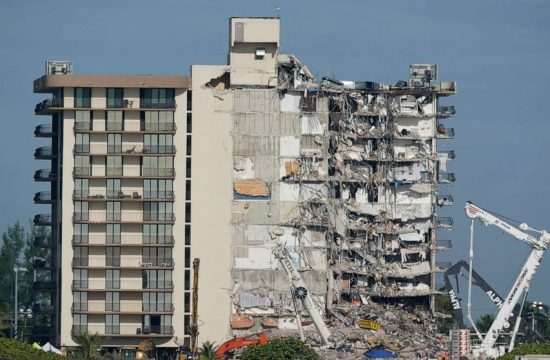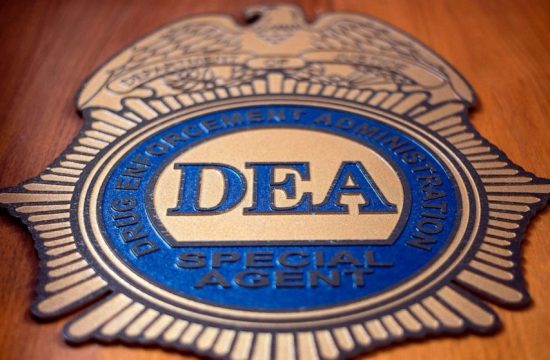Garrison Davis, a 17-year-old videographer and citizen journalist in Portland, Oregon, has documented the city’s Black Lives Matter protests against police brutality nearly every night since they began more than 50 days ago following the death of George Floyd.
Over the weekend, he posted images on Twitter of a group of moms who had created what they called a “Wall of Moms” to protect protesters. On the other side of their barrier, however, were not the city’s own police force, but rather federal authorities. A few hours after they’d formed the wall, the moms were among protesters who were tear gassed by these agents during violent clashes.
Some of the federal agents in Portland are part of a Department of Homeland Security task force established to respond to the growing protests and acts of civil disobedience that have occurred across the country. The U.S. Marshals Service, which operates under the Department of Justice and partners with the DHS’ Federal Protective Service to protect federal properties, had also been sent to the city. The DHS said these forces were there to protect the federal properties from “criminal acts of violence and vandalism.”
But as violence between the federal authorities and protesters increases, questions about their use of force and whether federal agents should be there in the first place have emerged.
“What’s going on here isn’t the federal government coming in to address real needs,” said Vera Eidelman, an attorney with the American Civil Liberties Union. “There are real needs elsewhere. It’s the government miscasting protesters as violent criminals and trying to scare people from going out and protesting police brutality.”
Davis told ABC News the federal agents began arriving around the Fourth of July and that within days he “saw Portland police pull back and the federal officers really take over trying to quell the protests.”
Those on the ground, however, say the federal agents have only inflamed tensions.
“The federal response, I think, caught a lot of people off guard,” said Davis. “A lot of people here were not ready for that. Protesters weren’t ready for that. Journalists were not expecting this to happen. So I think that definitely caught a lot of people off guard.”
Daryl Turner, president of the Portland Police Association, told ABC News that “every night we have violence — we have rocks, bottles, bioweapons thrown at us. … And we are showing great restraint.” He also called for the federal authorities to work “in concert with local police.”
“Right now, that’s not happening and that concerns me,” he said.
On July 11, Davis recorded video of a protester getting shot in the head by an impact round fired by a federal agent. The incident is now the subject of an investigation by the U.S. Marshals Service, which will be reviewed by the U.S. Department of Justice’s Office of the Inspector General, according to The Associated Press.
“I heard the impact. I heard him fall. I was standing like 10 feet away,” said Davis. “I immediately turned to the side and I saw his body just on the ground, just blood pouring from his head. People were grabbing him, pulling him into the park to get medical treatment. … His body was limp. His head bobbing around. He was taken to the hospital. His skull was fractured. … It’s that kind of unnecessary display of violence that didn’t accomplish anything and wasn’t a response to anything.”
Democratic Sen. Jeff Merkley of Oregon also raised alarms last week when he tweeted a video that had circulated online showing agents pulling up to arrest a protester in what appeared to be an unmarked van.
Mark Pettibone, another protester, says he too was taken by federal agents in an unmarked van and that he still doesn’t know why he was detained.
“We were stopped by a smaller group of protesters … and they warned us that there had been some vans that they saw driving around, basically snatching up protesters that were by themselves, away from larger crowds — kind of vulnerable,” Pettibone, 29, said. “And within seconds of them warning us about that, sure enough, one pulled up right in front of us. So I fled.”
Pettibone said he ran because he had “no idea who these people were.” They were dressed in unmarked military gear and they did not state why they were stopping the protesters, he said.
“So I feared for my life and I ran. They eventually caught up with me and pulled me into the van,” Pettibone said, adding that the men who grabbed him pulled his hat down over his eyes as they searched for weapons.
Acting Deputy Secretary of Homeland Security Ken Cuccinelli said Tuesday that federal agents had been deployed to Portland after 35 to 40 straight days of violence during which “we obtained intelligence that the federal facilities there were going to be targeted and were going to see directed violence.”
He said that officers were sent to help the base officers already present at these facilities and claimed the intelligence was correct. “Over the Fourth of July weekend, when we had advanced other officers to Portland, there were additional assaults on the individuals and the facilities themselves.”
Cuccinelli said that “as long as the violence continues at that level associated with federal facilities, we’ll have to maintain our elevated presence.” He also said all federal agents are in uniform.
“The same protesters are coming night after night. They all recognize them as uniformed and all of our agents that you’ve seen interact with any of these crowds have their insignia on their sleeves — they’re identified as police front and back — so Department of Homeland Security, Customs and Border Protection or Federal Protective Service. They are all clearly marked. They all identify themselves to individuals with whom they are interacting. For instance, if they are seizing somebody because they match the description of someone who assaulted a law enforcement officer, they identify themselves as federal agents immediately upon addressing that person. So that’s going on on a regular basis — that’s standard procedure.”
The incidents involving protesters being pulled into unmarked vehicles caught the attention of 53-year-old Christopher David, a U.S. Navy veteran, who said he was shocked by the agents’ actions.
“I saw the video of the men in combat fatigues with no insignia abducting citizens off the streets of Portland and stuffing them into unmarked vans,” David said. “And I was very concerned about that because if the federal government can do that, anybody can go to the store and … acquire used combat fatigues … get an unmarked minivan and then go off and abduct people off the streets. And we don’t know whether that’s the federal government or just a bunch of civilians playing dress up.”
David dressed in his old Naval Academy sweatshirt Saturday night when he attended the protests. He said he had hoped to start a dialogue with the federal agents, and remind them of their responsibility to defend American citizens and the Constitution.
“I took the oath of office — the oath of the Constitution — extremely seriously, and I know that all federal employees do as well, including those men who are down there attacking people and gassing people in downtown Portland,” David said. “And I wanted to ask them why they were no longer honoring their oath of office, why they were no longer honoring the Constitution, because what they were doing was blatantly unconstitutional.”
David wouldn’t see federal agents for most of the night, during which he said the protests were mostly peaceful. However, just as he was thinking about going home, he said eight to 10 of them came “rushing” out of the courthouse to confront a group of protesters.
“I had been standing in the park across from the courthouse when that happened,” he said. “So I walked into the street right in front of the courthouse. … And after they got done with that group, chasing them off, they came to me and surrounded me, and I started trying to talk to them. I said, ‘Why are you dishonoring your oath to the Constitution? Why are you doing unconstitutional things?'”
David said that as the officers approached him, one of them “about 3 feet away” pointed a semiautomatic weapon at his chest.
“Then another officer came and plowed into me … he knocked me off balance,” David said. “Then I plant myself right there. I’m going to stand my ground right there.”
David said he knew the federal agents were going to beat him. “So I put my hands down and I just took it,” he said. He suffered a broken hand in two places and was treated by medics on site before being taken to the hospital, he said.
“I wasn’t a real person. I was a target with that guy,” he said. “When that little dude started whacking me with his baton, I really wonder what he was thinking at that moment.”
David said he still doesn’t know who they are or what agency they’re from, and that he only saw alphanumeric codes on a little patch on their clothing.
Richard Cline, deputy director of the DHS’ Federal Protective Service, said during a press conference Tuesday that the incident involving David was being investigated.
The U.S. Marshals, whose officers were involved in the incident, told ABC News in part that their actions were based upon the circumstances at the time of the incident and that the deputies believed that the force used was necessary to protect themselves and others from physical harm.
Portland Mayor Ted Wheeler was among six mayors from across the U.S. on Monday who signed a letter demanding the federal government remove its agents from their cities, calling their deployment to the protests “unacceptable” and “chilling” and accusing Trump of “terror tactics.”
Wheeler told ABC News he wants federal authorities removed before the violence goes too far.
“Your presence here isn’t wanted,” he told ABC News of the federal agents. “It is clearly ratcheting up the violence and the vandalism. Local and state law enforcement can handle this, and we need you to leave right now before somebody dies.”
After months of unrest, the clashes in Portland seem far from over. But there is still hope about where the movement will lead next.
“I want to use my 15 minutes to put out a message to my fellow vets,” David said. “I also want to use my 15 minutes to try to refocus this whole discussion back to Black Lives Matter.”


